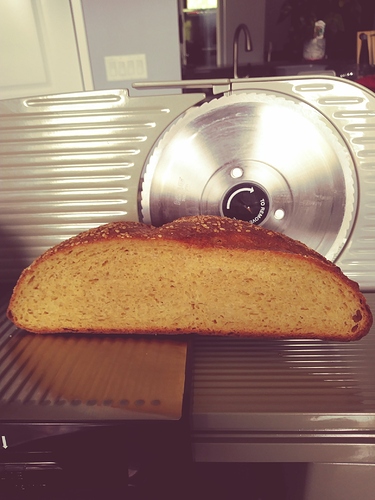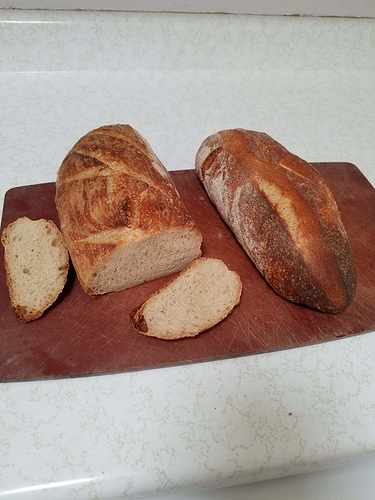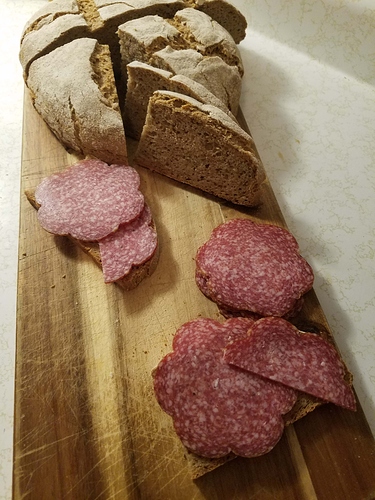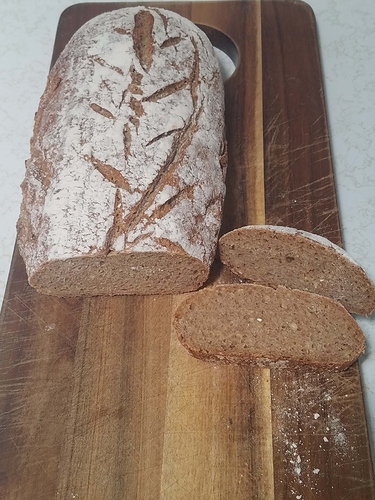I have been looking for information on Sifting ground whole grains to create other flours. Like the numbered flours of Europe, my understanding is that they have something sifted out after grinding. Also AP flour is created by sifting parts of the grain out of the flour. Are there any Books available that would cover the subject? Has Breadtopia ever published any information on the subject?
I would recommend buying lower protein berries such as organic soft white wheat berries, grinding and then sifting (fine mesh), a few times. Be prepared to make bran muffins too.
Robert I am assuming from your post you are looking to make either bread flour or AP flour from the whole grain for bread., rolls etc. The US does not use the numbered system for flours so I don’t pay much attention to as my old brain is too cluttered now. Without getting into all the technicalities these different flours in the US and overseas have different amounts of proteins and gluten in them. You can do a web search and find this info pretty easy. Content of the Heritage stuff though is not so easy. If dealing with store bought grains they have been hybridized to growing regions and different stock to increase yields. If flour they are processed and some with stuff I don’t want to eat. The AP or bread flour commercially purchased is not the same as any Ancient, Heritage or non-hybridized flour and has a greater gluten content. When they grind they are able to exactly remove bran and germ to whatever consistency they want. They can even give you a flour that will rise and make the typical “Wonder Bread.”
From my reading on the subject you can make “bolted” or sifted flour from a whole grain but even if you do it correctly using a 40 mesh screen it will be similar but not exactly like AP or bread flour so it will not bake up the same. You can remove the bran fairly easy and the germ if you want to play with different grinds and sifting numerous times. If you set the grind slightly coarser than fine you can get the bran out, then after the bran is out run the flour thru the mill again at a finer setting. You have to play with it as all mills are different.
I grind my flour on the finest setting of the Mockmill then sift if I want to like I did yesterday to make the Sicilian No Knead Bread. I used Kamut instead of the white bread flour and added vital wheat gluten to make up for the lack of in the other grains. I feel I had mixed results results with rise. Texture was excellent, light but no large holes. I HAVE YET been able to get whole wheat to give me these large holes in the bread so either it is because of the heritage wheat or I am doing something wrong. I am new at this myself as I don’t even have a year under my belt with whole grains and baking with.
Here is a screen shot of Eric’s bread with the big holes.
Here is mine with the bolted whole grain. My rendition of Kamut Bread Flour.
Exterior looks like Eric’s but crumb not the same.
Would be glad to hear from others on this issue as I would like to produce the rustic breads using the Heritage whole grains.
https://www.virtuousbread.com/bread-and-conversation/what-is-italian-00-flour/
I ran across this article which you may find interesting on the subject. Found when looking for something else.
My Question was more based on the fact that I am looking at purchasing a Mockmill in the future, and I was trying to determine if I can grind all the types of Flour I would need or if I need to purchase some of them. I make mostly the heaver Rye type breads of Germany, but they use both Whole Wheat and high protein white flours along with Rye. (eg. All Trumps). My simplistic understanding of the difference in European flours is “the higher the number the more of the grain is in the flour”.
As far as the larger wholes in the bread, try a higher hydration of your dough and after the first rest period stretch and fold the dough 8 times in two hours to get the gluten strength you need. then let it raise for baking.
There are a few great books with a lot of information for us beginners, one I started with is “Reinhart, Peter. Peter Reinhart’s Whole Grain Breads: New Techniques, Extraordinary Flavor. Kindle Edition.”. Good Luck with your bread baking.
Here are a few of the breads I have been making…
@mnman, I consider myself to be a novice bread baker. Being on Breadtopia has taught me SO much about baking REAL bread since I first stumbled across it in February 2018. I had been SO disappointed in store-bought bread. I was making improvements in my diet and wanted to eat more simply with more organic ingredients, fruits and veggies. Basically I just wanted to make better, healthier choices. I wanted REAL bread, not a chemical laden cornucopia of ingredients and I wanted to avoid commercial yeast, at least at home. God bless Breadtopia! A good friend of mine locally had developed a faithful sourdough starter she had been using for years. She gifted me a portion of her starter one evening. That’s how I got my sourdough starter, whom I named Cyril and when my bread baking journey began! I purchased a Mockmill 100 that month! I cultivated, fed, talked to and just loved on Cyril until I felt he was acclimated and ready to bake. In April 2018 I baked my very first loaf of sourdough, EVER! I’ve been hooked since!
About the Mockmill – I LOVE IT! At the time I purchased mine, the Mockmill Pro did not exist. IF I didn’t already own my Mockmill 100 and was looking to purchase a new mill, I would spend the extra money and buy the Pro simply for ease of set up and use. But I will admit to you that I am more than happy with my Mockmill 100. I bake a loaf or two of bread about every 10 days as we’re empty-nesters these days (unless you count our pup who rules the roost and allows us to live here). I’m not baking numerous loaves on a daily or weekly basis nor am I baking for a large family. Grinding speed was not a big issue for me which is why I opted for the Mockmill 100 versus the 200 at the time. And yes, the 100 did cost less, LOL. The instructions that come with the Mockmill will let you know exactly what types of grains can be and those which should not be milled. Oily grains/nuts/seeds and coffee should not be milled because they will leave an oily film on the grinding stones rendering them unable to properly grind your grain. The Mockmill is easy to “clean” from time to time by choosing a coarser setting for the stones and grinding some plain white rice. I do urge you to thoroughly read the instructions and keep them for ongoing reference. I do believe that most grains you would be considering grinding for bread baking can be ground on the Mockmill. In my personal experience I have only used my Mockmill to grind rye, Turkey Red, Red Fife and hard white wheat.
Enjoy your bread baking journey. I know I have!
Leah
“AP Flour” like the white all purpose flour that you can buy in a grocery store is not created by sifting stone ground whole flour. It is created by milling wheat with a modern roller mill, an industrial mill created to mill very fine and specifically to separate all the bran and germ away from the endosperm (starch) in wheat. White flour is essentially very finely milled, 100% endosperm with effectively zero bran and germ.
If you home mill (using a countertop stone grain mill) whole berries and then sift the resulting flour with progressively finer sifters, you will take out more and more of the bran and the germ (which doesn’t mill as fine as the endosperm) and the result of each sifting will be closer and closer to white flour. But you are never going to really approximate the fineness and purity of commercially roller-milled flour with a stone grain mill and some hand sifters.
Flour sifted like this is generally called either “bolted” or “high extraction” flour and some bread bakers talk about extraction percentages. For example, an 85% high extraction flour is one where 15% of the weight of the whole grain has been sifted out.
Such bolted or high extraction flour generally performs somewhere in between a whole grain flour and a white flour, and the higher the extraction (lower the extraction percentage number) the closer you get to white flour performance. By that I mean a smoother, more extensible, more elastic dough that is easier to shape and tends to give you a better rise and a more open crumb.
At the same time, the higher the extraction, the more of the whole grain nutrition you have stripped out of the flour as well as much of the interesting flavor profile of a given grain. This is one of many trade-offs in bread baking.
Finally, something that makes sense. Thanks for the comment.
Thank you for that post. I have been baking breads and pizza doughs using Ken Forkish’s books and just got a mill for my birthday. Trying to figure out how to substitute fresh milled flour for my starter, bread, and pizza dough has been a challenge.
I’m reactivating my starter now with only white winter wheat instead of store bought whole wheat + white and then I’ll be doing a loaf of sourdough with the winter wheat + a touch of rye and exclude the whole wheat. My guess, based on your post, is that the bread will be denser but more flavorful than my typical loaf. Worst case, the birds and squirrels get a treat! Hey…it’s only flour.
My next milling exercise will be finer (I did a mid level grind and noticed that the refreshed starter felt a bit grainy compared to what I’m used to - I mix with my hands). I’m also going to order Reinhart’s book; that looks like it might be a good place to start.
Thank you again for the info (and I propose this and the tread on ancient grains be turned into ‘sticky posts’ and loaded at the top of the forum for all the noobs! (side note: I’ve only just started poking around here and may have missed exactly what I’m looking for which is one or more ‘welcome to milling and baking…things to know, do, and avoid’ posts.





